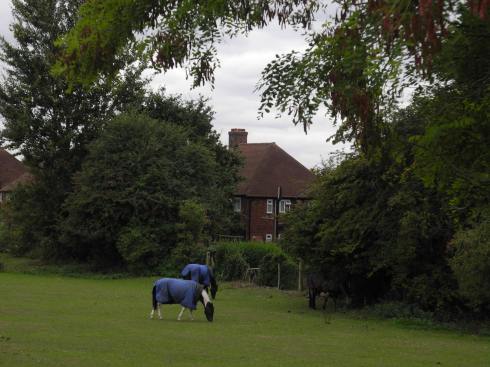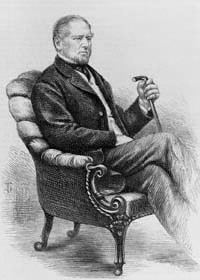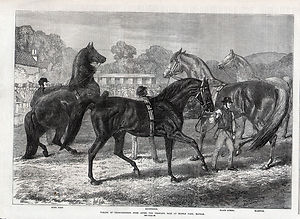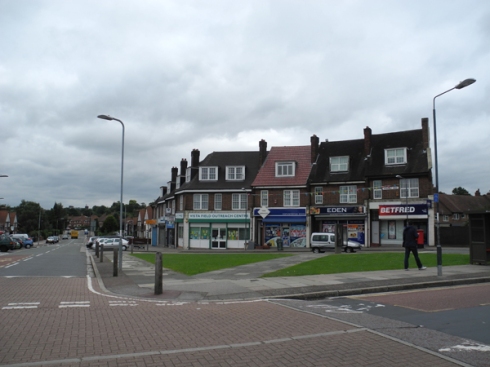You are currently browsing the tag archive for the ‘Eltham palace’ tag.
This is a part of the town only known to walkers and those with a long association with the place. Located at the back of Eltham Palace it is an ancient right of way which is now part of the Green Chain Walk. As you approach Eltham Palace its worth taking some time to look at the texture of the brick work along Court Yard and Tilt Yard defying time still standing but bowing. The walls date back to the 16th C and are listed. Take the path at the side of the Palace main entrance passing some Tudor style mansions. There is a turning to the left marked by the Green Chain sign and an iron gate with a White Tudor Rose. This is King John’s Walk.
The vast panorama tricks you to think that you are in the middle of Kent rather than a mere half mile from the High Street. This path originally linked the Palace with the hunting estates of Middle Park and the Great Park. There is still sufficient open space to get a feel of what it was like when it was a hunting park. The path is named after Prince John of Eltham born at the Palace in 1316 to Edward ll and Queen Isabella. It is also associated with the French King Jean Le Bon who was held captive at the Palace after the Battle of Poitier 1356. It is said that he used to exercise here. The familiar London skyline of the Shard, London Eye, Walkie Talkie, Canary Wharf and Millennium Dome can be seen from the path. Over to the West is a view of Crystal Palace. At the Green Chain sign post take the right hand path towards The Tarn.
There is a field of donkeys and a couple of mules. Yes, and you are still in Eltham. They are quite friendly and will move towards you as you walk along the path. The path crosses the boundary of the Middle Park Estate crossing Court Road and into The Tarn.
At the entrance there is a C18th brick ice well built to supply Eltham Lodge. Built in 1664 it is now the Royal Blackheath Golf Club which is set back from Court Road. The Tarn is named after the lake which is the main feature of the small park. Eltham Lodge and the Tarn were once within the Great Park of Eltham Palace. To return to the High Street take Court Road. The walk will take about an hour or more if you spend more time with the donkeys.
Guest Post by BK
The Middle Park Stakes is run on October 12 this year on the famous Rowley Mile at Newmarket; where it has been held nearly every year since 1866. It is one of the most important races for 2-year old horses in the racing calendar and provides an important test for the following year’s prospective 200-Guineas and Derby entrants. Few people now realise that it shares its heritage with an estate in Eltham, perhaps most famous as the home of Boy George.
From the 16th to the 19th century Eltham was mainly farm and park land dominated by Eltham Palace. Originally the Palace estate was divided into 3; The Great Park; The Little, or Middle, Park; and Home, or Lee, Park. They were mainly wooded areas which provided land for deer-hunting. During the Commonwealth Cromwell’s troops killed the deer; and the trees were pulled down for shipbuilding. A survey of 1649 of Cromwell’s estates reported ‘The Middle Park, 333 acres 2 rods 7 perches. The deer and park all destroyed, and the park disparked by the soldiery and common people since the summer before. The trees marked for The Navy 1,000. The rest old and fit for fire. 334 worth £162.’ With The Restoration, Charles II gave the estates to his financier, Sir John Shaw, who built a grand house called Eltham Lodge, the Palace having fallen into disrepair. Great Park is now Royal Blackheath Golf Club and the Lodge is the clubhouse.
Middle Park served as a farm providing food for residents of The Great Park until it was sold in 1852. William Blenkiron was a Yorkshireman who was a successful business agent and manufacturer of socks and collars; but his main interest was breeding thoroughbred horses. He bought his first in 1847 and became so successful that he expanded by moving to Middle Park.
His success continued. In 1856, his first sale had 14 lots; by 1866, the year he endowed the race named after his farm; he gave a prize of 1,001 guineas, presumably to go one better than the classic race that is also run over the Rowley Mile; he had to expand to two sales per year. The sale had 58 lots and was worth £17,905 guineas. The sales were attended by nobility from Britain and even Europe.
Middle Park was by now the largest and most successful stud in the world and considered to be one of the biggest attractions in the country. Middle Park under William Blenkiron produced four Derby winners amongst a host of other classic victories. In 1867 his horse Hermit won in a snowstorm, beating Marksman which was another Middle Park product. The success was due to Blenkiron’s new theories and interest in horse breeding and the inheritance of genetic characteristics. He even corresponded on these matters with non-other than Charles Darwin who lived nearby at Downe House in Bromley.
He died at Middle Park on 25 September 1871 and he is buried in Eltham churchyard. His son then sold the stud in 1872 for 124,620 guineas. The land gradually reverted to agriculture until it was bought by Woolwich Corporation in 1931 to build housing.
Thus came to an end Eltham’s brief interlude as the world centre for horse-breeding. All that is left is the memorial in Eltham church yard and the shopping mall in the centre of Middle Park called Newmarket Green. At least they could have named a street after him.
Walking around the gardens of Eltham Palace it’s hard to believe that the High Street is only five minutes away. You could be forgiven for thinking you were in the middle of rural Kent. Entrance to the Palace by foot is via Tilt Yard Approach or by Court Road. Now both of these roads have some interesting brick walls. Yes, I do think brick walls can be interesting. They date back to the 16th Century and have that texture that only comes with age. In fact the wall between number 34 and 36 Court Yard is listed and is on English Heritage’s at risk register. You will also notice the Tiltyard gate which would have been the entrance to the jousting area of the palace.
The original palace dates back to Edward ll 1305. Later the young Henry Vlll grew up here. Much of the old palace is now a ruin except for the Great Hall with its stunning hammer beam ceiling. In the 1930s the ruin was bought by the wealthy Courtauld family who built the Art Deco house. The two very different types of architecture 20th Century and Medieval do work in harmony.

A tour of the interior will take you back to pre-war decadence. For me it is not so much the luxurious gold bathroom, stunning entrance but the home movies of Ginny and Stephen that make you realise how fabulously wealthy they were. The house has been used in several films, advertisements and videos so is very recognisable.
After the Second World War the house became the headquarters of the Army Education Corp up until 1992. It must have fallen into disrepair at some point as this old photograph of the Tiltyard gate reveals. I have also spoken to a neighbour who worked at the palace some years ago. She told me that one of the best fireplaces were taken from the palace and were bought by the Greyhound public house which is now the Yak and Yeti restaurant in the High Street. It is a 15th Century stone fireplace with a Tudor arch and carved spandrels.












